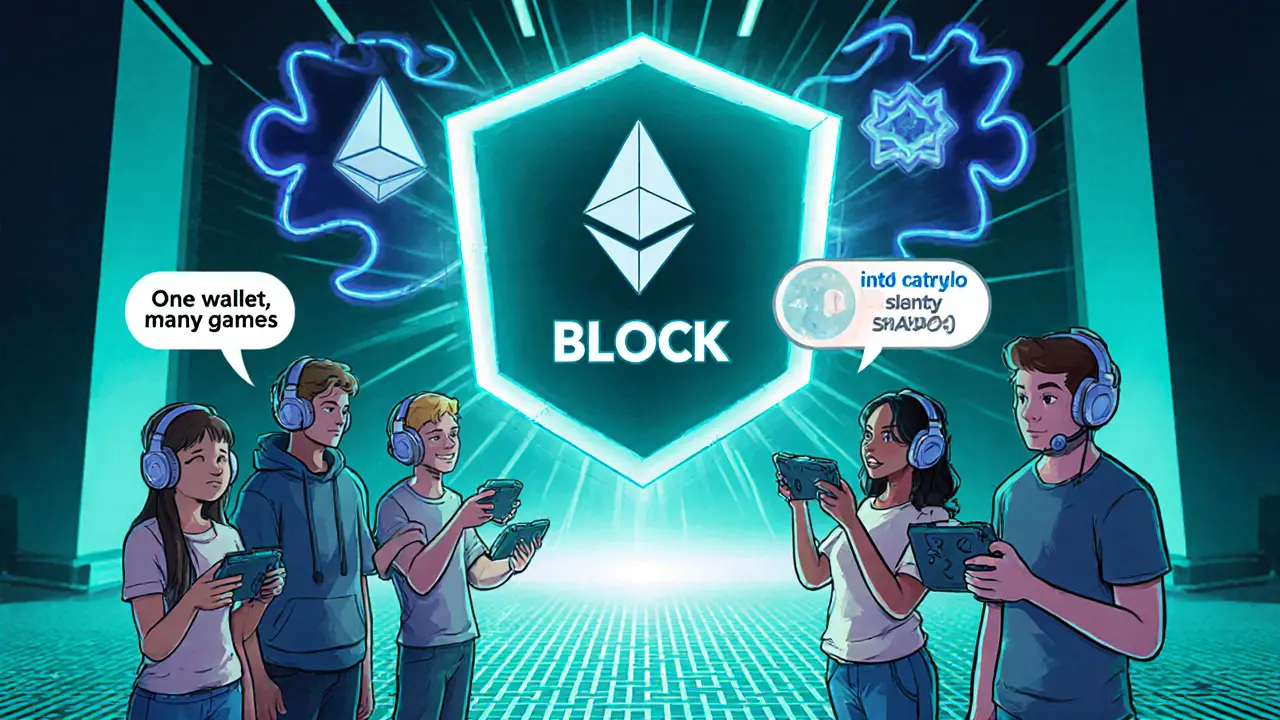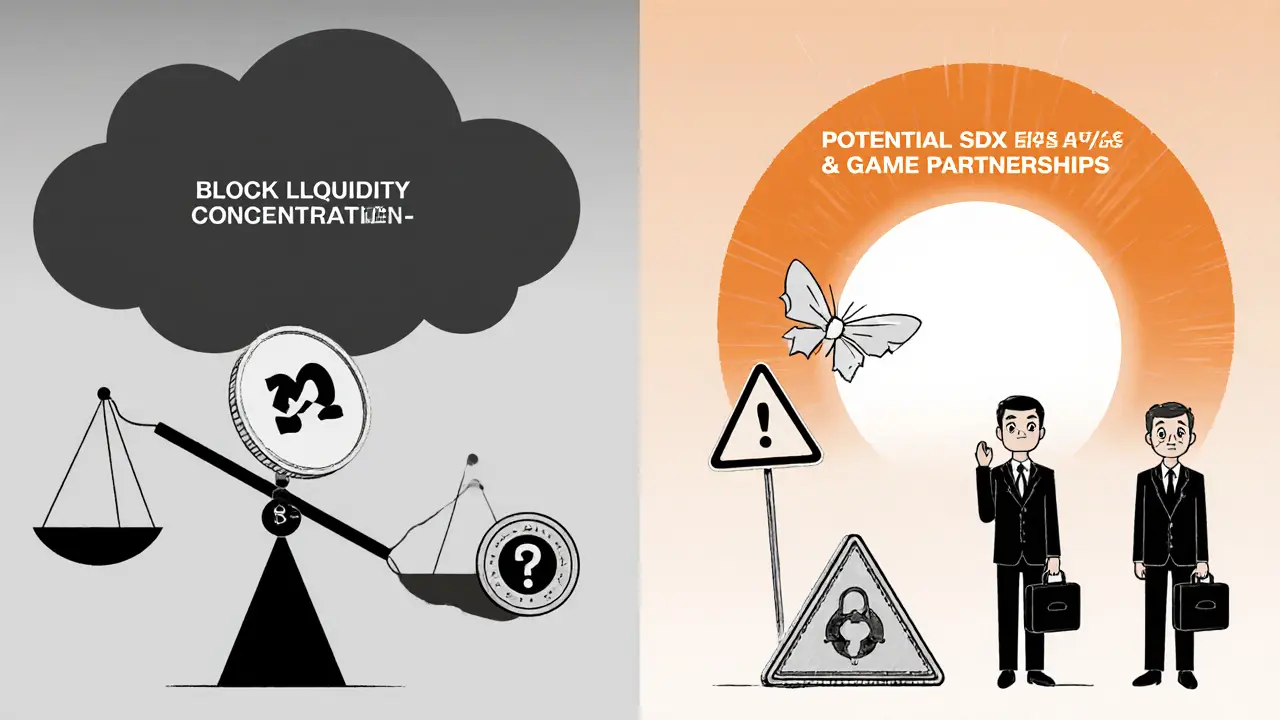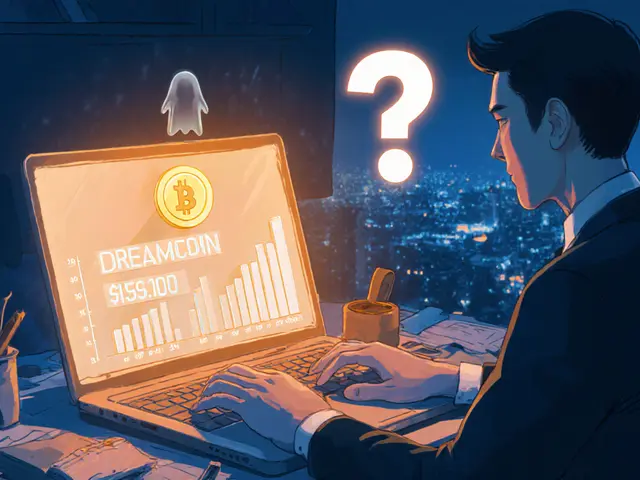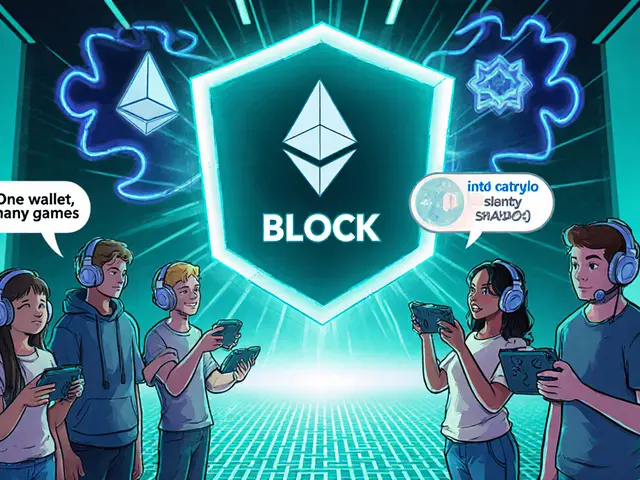BlockProtocol (BLOCK) Coin Explained - Basics, Tokenomics & Current Price

BLOCK ROI Calculator
Calculate Your ROI
How It Works
BlockProtocol (BLOCK) launched at $0.06 during its IDO in March 2024. Today, prices vary widely across exchanges. This calculator shows your return based on your purchase price and the current price you choose.
Price Discrepancy Notice:
Different exchanges show different BLOCK prices: $0.06027 (Dropstab), $0.000551 (Binance), $0.0003479 (CoinMarketCap). Always check your exchange's liquidity before trading.
Your ROI Result
Quick Takeaways
- BlockProtocol is a cross‑chain, decentralized player‑network crypto aimed at the gaming sector.
- The BLOCK token launched via an IDO in March2024 at $0.06, but today trades well below that price.
- Total supply: 1billionBLOCK; circulating supply figures vary widely across data sites.
- Major backers include Susquehanna International Group, Aptos, Sfermion and Mapleblock Capital.
- Primary liquidity lives on MEXC, with smaller pools on Gate.io, KuCoin and Uniswap V2.
What is BlockProtocol?
BlockProtocol is a cross‑chain, decentralized player‑network cryptocurrency (ticker: BLOCK) built to accelerate user growth for blockchain games. The project started as BlockGames, rebranded to BlockProtocol in early 2024, and now positions itself as the infrastructure layer that lets developers share player data, assets and identity across multiple games and blockchains.
Think of it as a shared lobby for gamers. Instead of creating a new wallet or token every time you hop to a different game, BlockProtocol promises a single on‑chain identity that works everywhere. In theory, that reduces friction for both players and developers, potentially driving higher retention and faster network effects.
How does the BLOCK token work?
The native token, called BLOCK, fuels the protocol in three ways:
- Transaction fees: Developers pay a small fee in BLOCK when they write or read player data on the network.
- Staking incentives: Validators who secure the cross‑chain bridges stake BLOCK and earn rewards.
- Governance: Holders can vote on protocol upgrades, fee structures and partner integrations.
All of these functions aim to create demand for the token while keeping the supply relatively fixed. The token follows the ERC‑20 standard on Ethereum, with the contract address beginning with 0x8fc1 and ending in 9CB53A.
Tokenomics & Supply Details
Key numbers from the launch:
- Total supply: 1billion BLOCK.
- Public sale allocation: 0.13% (1.25million tokens).
- Initial circulating supply: 184.10million BLOCK.
- Initial market cap: $11.05million; fully‑diluted valuation (FDV): $60million.
Since launch, the reported circulating supply has jumped around - data sites list anywhere between 83million and 679million tokens. The discrepancy likely stems from differing definitions of “locked” versus “unlocked” tokens on various exchanges.
Market Performance & Price Discrepancies
BLOCK’s price has been extremely volatile. Depending on the tracking platform, you’ll see three very different numbers:
- Binance’s ticker shows $0.000551 with a market cap of around $45,900.
- Dropstab reports $0.06027 and a market cap over $411,000.
- CoinMarketCap lists $0.0003479 and a market cap near $287,650.
Such gaps usually happen when platforms track different trading pairs (e.g., USDT vs. BUSD) or even separate smart‑contract deployments. The bottom line? Early investors who bought at the IDO price of $0.06 have seen a loss of roughly 99% - a return on investment (ROI) of 0.01× according to Cryptorank. The token did enjoy a brief rally that pushed the ROI up to 9.94×, but that burst has long faded.
Who’s backing BlockProtocol?
The project attracted a fairly heavyweight investor list for a gaming‑focused token:
- Susquehanna International Group - a global quantitative trading firm.
- Aptos - a fast‑growing Layer‑1 blockchain.
- Sfermion - venture capital focused on blockchain gaming.
- Mapleblock Capital - another gaming‑centric VC.
- Cypher Capital and several Tier‑3 investors round out a total of 22 backing entities.
These names signal that institutional money saw potential in the cross‑chain vision, even if market reality has been harsh.
Where can you trade BLOCK?
Liquidity is split across a handful of exchanges, with the lion’s share on MEXC (about 90% of daily volume). The typical BLOCK/USDT pair on MEXC trades near $0.0603 and moves roughly $317k per day.
Other venues include:
- Gate.io - offers a 3× leveraged BLOCK/USDT contract.
- KuCoin - smaller pool, price around $0.000605.
- Uniswap V2 (Ethereum) - the most limited liquidity, often under $200 of daily volume.
Binance does not list BLOCK for direct trading, though it provides a price ticker that pulls data from other markets.
Technical Outlook & Cross‑Chain Vision
While the whitepaper remains terse, the protocol claims to enable interoperability between multiple blockchains. In practice, that means a game built on Ethereum could read a player’s avatar owned on Solana without a separate bridge. The underlying tech likely uses a set of smart contracts acting as custodians for cross‑chain state, but the exact consensus mechanism (Proof‑of‑Stake, Proof‑of‑Authority, etc.) has not been publicly detailed.
If the team can deliver seamless cross‑chain identity, developers could save on gas fees and onboarding friction - a real selling point in a market where many projects still lock users into a single chain.

Risks and Outlook
Investors should weigh several red flags before buying BLOCK:
- Price volatility: The token is down over 95% from its launch valuation.
- Supply transparency: Conflicting circulating‑supply numbers make market‑cap calculations unreliable.
- Development silence: No new roadmap updates, GitHub repos, or partnership announcements since mid‑2024.
- Liquidity concentration: Over 90% of trade volume sits on a single exchange (MEXC), raising counterparty risk.
On the upside, the backing investors could still fund a technical pivot, and the gaming‑infrastructure niche remains under‑served. If BlockProtocol releases robust SDKs and secures a marquee game partnership, the token could see a resurgence.
How does BLOCK compare to other gaming tokens?
| Token | Launch Year | Total Supply | Current Price (USD) | Market Cap (USD) |
|---|---|---|---|---|
| BlockProtocol (BLOCK) | 2024 | 1B | ~0.0005 | ~$45K |
| Enjin (ENJ) | 2017 | 1B | ~0.20 | ~$2B |
| Illuvium (ILV) | 2021 | 10M | ~6.00 | ~$3B |
BLOCK sits at the low‑end of both price and market cap, reflecting its early‑stage status and recent price collapse. Enjin and Illuvium enjoy broader adoption, deeper liquidity and more transparent supply metrics.
Next Steps for Interested Readers
If you’re curious enough to watch BLOCK, consider these actions:
- Set up a non‑custodial wallet (MetaMask or Trust Wallet) that supports ERC‑20 tokens.
- Buy USDT on a major exchange, then transfer it to MEXC or Gate.io.
- Place a small market order for BLOCK/USDT - start with an amount you’re comfortable losing.
- Follow the project’s official channels (Telegram, Discord) for any development updates.
- Benchmark BLOCK against other gaming tokens using the table above before committing more capital.
Remember, crypto investments are high‑risk. Only allocate money you can afford to lose.
Frequently Asked Questions
What does BLOCK stand for?
BLOCK is simply the ticker symbol for the native token of the BlockProtocol network. It doesn’t represent an acronym; it reflects the project’s name.
How can I store BLOCK safely?
Since BLOCK follows the ERC‑20 standard, any wallet that supports Ethereum tokens (MetaMask, Trust Wallet, Ledger hardware wallet) can hold it. Always back up your seed phrase.
Is BLOCK profitable to stake?
The protocol promises staking rewards for validators, but the exact APY isn’t publicly disclosed. Without clear numbers, staking profitability is uncertain.
Why do price feeds show different BLOCK prices?
Different sites track different trading pairs (USDT, BUSD, etc.) and sometimes pull data from separate smart‑contract deployments. That creates the wide price gaps you see.
What’s the long‑term outlook for BlockProtocol?
If the team delivers functional cross‑chain SDKs and lands a major game partnership, BLOCK could rebound. However, the current lack of updates and volatile price suggest high risk for now.


Manas Patil
From a technical standpoint, BlockProtocol's cross‑chain interoperability hinges on a suite of state‑sync validators and SDK wrappers that abstract away the underlying consensus differences. In practice, developers can instantiate a single player‑identity contract on Ethereum and query it from a Solana‑based title via a bridge oracle. This pattern reduces gas overhead and mitigates the “wallet fatigue” problem that plagues multi‑chain gaming ecosystems. The tokenomics model supports this architecture by allocating a portion of transaction fees to validator staking pools, thereby aligning incentives across chains. If the protocol can deliver low‑latency reads, it could become a de‑facto standard for cross‑game asset portability.
Melanie Birt
Heads‑up for anyone diving into BLOCK: the circulating‑supply numbers are all over the place, so always double‑check the exchange’s page before you trade. The discrepancy between Dropstab and Binance is a classic case of different pairings (USDT vs BUSD) inflating the price on one platform. Also, keep an eye on liquidity depth – most of the volume lives on MEXC, which can lead to slippage on smaller orders. A quick tip: set limit orders a few ticks away from the market price to avoid getting caught in a spread swing. Happy hunting! :)
Annie McCullough
Sure the hype says it’s a game‑changer but the reality shows a token stuck at sub‑cent levels with almost no dev updates its like a ghost project lol
Sanjay Lago
Totally get the concern, but let’s keep it light – the team might just be working under the radar. Stay optimistic, keep your exposure tiny and watch for any roadmap tease. If they drop a solid SDK next month, we’ll all be glad we held on. Also, I typo‑ed “block” as “blcok” a few times, sorry about that!
Nathan Van Myall
The price irregularities largely stem from differing base currencies and the fact that some platforms pull from secondary market makers. When you compare a USDT pair on MEXC to a BUSD pair on Binance, you’ll see a spread that can look like a huge arbitrage opportunity but often isn’t executable due to depth constraints. It’s wise to monitor the order book depth and use decentralized aggregators if you want a more accurate mid‑price. In any case, treat BLOCK as a speculative asset with a high risk‑reward profile.
debby martha
i feel like this token is just another hypewave i cant be bothered to track it all day lol
Orlando Lucas
Philosophically speaking, the notion of a universal player identity touches on the archetype of the “connected self” that transcends individual games. Practically, though, the market data suggests that most users aren’t ready to abandon native wallets for a meta‑layer. The project’s lack of transparent supply metrics creates a trust deficit that is hard to overcome without concrete milestones. Yet, if they manage to secure a partnership with a top‑tier AAA title, user adoption could spike dramatically. In the meantime, treat BLOCK as a high‑variance bet, allocate only what you can afford to lose, and keep an eye on the liquidity pools for any sudden inflows that might hint at institutional interest. Lastly, the community chatter on Discord has been quiet lately, which is both a warning sign and an opportunity for early adopters to shape the narrative.
Carol Fisher
Honestly, the whole "cross‑chain gaming" narrative feels like a marketing gimmick until I see real numbers. 🌐🚀💥 If they pull off seamless asset transfer, great, but right now I see a lot of hype and a little substance. 🤔💭🛑
hrishchika Kumar
I understand the excitement around a unified gaming identity, and it does sound inclusive. That said, we should also be mindful of the security implications of aggregating player data across chains. A breach could affect multiple ecosystems simultaneously, so robust audits are a must. Let’s hope the developers prioritize formal verification before scaling.
Lena Vega
Good point, thanks for the heads‑up.
Mureil Stueber
When evaluating a nascent protocol like BlockProtocol, it's essential to break down the fundamentals into digestible components. First, the cross‑chain design proposes a shared player identity, which, if implemented correctly, could lower onboarding friction for gamers shifting between ecosystems. Second, the tokenomics allocate a modest portion of transaction fees to staking rewards, aligning validator incentives with network health. Third, the circulating‑supply discrepancies you noted stem from differing definitions of locked versus unlocked tokens across data aggregators, a common issue in many newer projects. Fourth, the heavy reliance on a single exchange for liquidity amplifies counter‑party risk, meaning any withdrawal of market‑making activity could cause price spikes or crash. Fifth, partnership history shows backing from credible firms like Susquehanna and Aptos, indicating that institutional interest exists, though it may be more speculative than strategic at this stage. Sixth, the roadmap transparency is currently lacking; a public GitHub with recent commits would significantly boost confidence. Seventh, the market price variance across platforms underscores the importance of using a single, reputable source for price checks before executing trades. Eighth, the token’s current valuation suggests a high‑risk, high‑reward profile, where upside potential is present only if the cross‑chain SDKs become widely adopted. Ninth, developers should monitor the on‑chain activity metrics, such as daily active addresses, to gauge real usage versus speculative holding. Tenth, regulatory considerations around cross‑chain data sharing could become a hurdle in jurisdictions with strict data privacy laws. Eleventh, community sentiment on Discord and Telegram remains muted, which could indicate either a strategic silence or waning interest. Twelfth, future token burns or lock‑up releases could further muddy the circulating‑supply picture, so any investor should demand clear communication on future supply events. Thirteenth, if the team releases a public audit of the bridge contracts, that would mitigate many security concerns. Fourteenth, the potential for integrating with existing game engines like Unity or Unreal could drive developer adoption, but that hinges on robust documentation. Fifteenth, overall, treat BLOCK as a speculative play, allocate a modest portion of your portfolio, and stay vigilant for any roadmap updates or partnership announcements that could shift the risk calculus.
Emily Kondrk
Did you ever notice how every “new” token that promises cross‑chain magic is actually a front for a hidden agenda? I’m convinced there’s a covert consortium funneling liquidity to manipulate price feeds. The fact that Binance only shows a ticker without real trading is a red flag. Keep your eyes peeled.
Anjali Govind
Yo, just wanted to say the concept sounds lit but the community vibe is kinda dead. If they drop a dev update soon, I might swing back. For now, I’m just watching the charts and sipping coffee.
Lady Celeste
Finally, someone actually acknowledges the drama.
Ethan Chambers
One must question whether the ostensibly revolutionary architecture is merely a veneer for speculative gymnastics. In an ecosystem saturated with tokenomics gimmicks, the purported cross‑chain utility of BLOCK appears, at best, an academic exercise devoid of pragmatic implementation. Such projects often masquerade as avant‑garde while neglecting the essential rigor required for sustainable adoption.
Rama Julianto
Look, the data is messy but you can’t just dismiss a project because the numbers aren’t pretty yet. The backers are serious, and the tech can actually work if they double down on dev resources. Stop being so cynical and give them a chance to prove themselves.
Scott Hall
For anyone still on the fence, remember that diversification is key. Adding a small position in BLOCK could be a good way to test the waters without overexposing yourself. Keep your stop‑loss tight and watch for any community updates that might signal a shift in momentum.
Jade Hibbert
Sure, because adding another meme‑token to my portfolio is exactly what I needed to feel like a responsible investor. 🙄
Leynda Jeane Erwin
Dear participants, I must stress that while the conversational tone herein is casual, the underlying financial considerations demand a formal assessment. Please ensure you conduct thorough due diligence before allocating capital to the aforementioned asset.